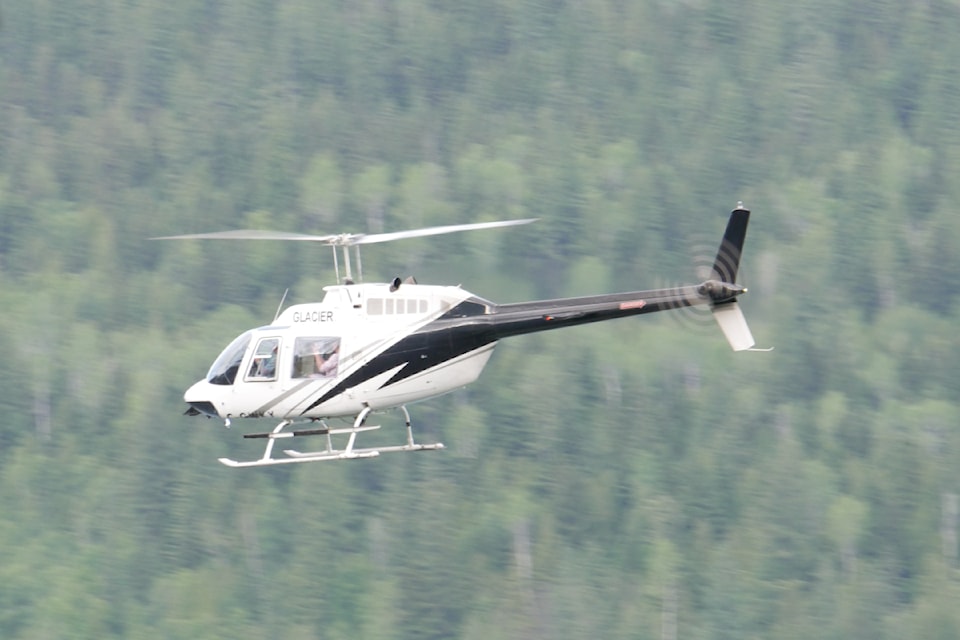A student helicopter pilot who fatally crashed east of Revelstoke was flying unsupervised in "poor weather" and with a substance in his bloodstream, according to Canada's independent transport safety agency.
The Transportation Safety Board of Canada (TSB) shared its full report Thursday, July 25, of the incident where the aircraft came down in trees, snow and flames just out of sight off the Trans-Canada Highway.
The crash happened Jan. 5, 2024, less than seven kilometres southwest along Highway 1 from the Giant Cedars Boardwalk. The Bell 206B helicopter, registered to the Oklahoma-based Aircraft Guaranty Corporation, had only the pilot on board and was flying from High River, Alta., to a private property in Sicamous.
"During the flight, the pilot received information via a text message that stated he would encounter low clouds at Canmore, Alberta," the report reads. "The pilot sent a reply indicating that he had encountered poor weather and would take the (visual flight rules) route along the Trans-Canada Highway through Rogers Pass."
It's noted that on previous flights along this route, the pilot flew more directly over the mountains as weather allowed.
He'd left High River in "favourable weather," according to TSB, but likely encountered lower clouds, reduced visibility and strong winds west of Golden, with Environment and Climate Change Canada identifying a warm front moving through the region at the time.
"As the helicopter neared Revelstoke, the visibility would have been further reduced by precipitation with an increase in wind speed and turbulence as the warm front passed," the report says.
Someone last identified the helicopter about 20 nautical miles (37 kilometres) southwest of Rogers Pass, flying through fog and 15 to 30 metres above the treeline along the south side of Highway 1.
"At approximately 4:40 p.m., the helicopter made a right turn in a northwest direction and flew across the highway toward upsloping terrain," TSB states. "No further visual contact was reported."
The Canadian Mission Control Centre received a signal from the helicopter's emergency locator transmitter nearly two hours later at 6:25 p.m., upon which search and rescue units were deployed.
With search efforts "hampered by decreasing daylight, poor weather, and challenging terrain," a Canadian Armed Forces helicopter located the crashed Bell 206B shortly before noon Jan. 7, two days later.
"It was in deep snow and on a treed slope approximately 70 feet (21 metres) uphill and north-northwest of the Trans-Canada Highway," TSB says. "The pilot was fatally injured, and the helicopter was destroyed."
TSB adds that while the helicopter's 406-megahertz signal frequency was working fine for GPS purposes, its 121.5-megahertz frequency, which search and rescue crews rely on, malfunctioned, likely delaying the emergency response further.
After crews reached the helicopter Jan. 7, TSB announced on Jan. 10 it would deploy a team to investigate the circumstances of the crash.
The male victim, unnamed in the report, had a Canadian student helicopter pilot permit for more than five years, and 205 flight hours for that particular helicopter, including 83 hours flying solo. Previously, he'd last flown the helicopter on Oct. 20, 2023.
While the pilot has passed the required test and written examinations for private flying, "there was no record that an application had been filed for a private pilot licence nor was the pilot granted additional privileges on his student pilot permit," TSB says.
And though the pilot had informed a "responsible person" of his itinerary in advance and communicated during the flight about revised arrival time and weather, "the student pilot permit requires that all solo flights be conducted under the direction or supervision of a flight instructor, which was not the case."
Toxicology results additionally found that the pilot's bloodstream contained a substance "not permitted when operating an aircraft," which may have come from an illicit drug or medication he consumed. However, whether this influenced the pilot's flight performance on Jan. 5, 2024, remains unknown.
Upon crashing, the pilot was wearing a four-point safety belt, but no helmet, which TSB clarifies isn't required by Canadian Aviation Regulations.
Regardless, "the accident was not survivable because of the impact forces involved."
The TSB concludes its report by advising pilots to proactively review the weather along their route and how it may affect them, to avoid potentially worsening conditions from disorienting them and causing them to fly into terrain.
"All pilots ÎÚÑ»´«Ã½” no matter how experienced they are ÎÚÑ»´«Ã½” must take early, decisive action when conditions are not suitable for continued flight," states the TSB.


